Update: The full feature review of the Leben Hi-Fi Stereo Company CS-300F vacuum tube integrated amplifier has now been published at Positive Feedback. You can read it HERE.
As is my custom, I like to give you a 'review sneak peek' into my soon to be published feature articles for Positive Feedback.
This time the feature article 'sneak peek' is about the Leben Hi-Fi Stereo Company CS-300F vacuum tube integrated amplifier.
The full article will be published at Positive Feedback in the next few weeks, so stay tuned for more!
Enjoy!
Leben Hi-Fi Stereo Company CS-300F Vacuum Tube Integrated Amplifier - A Blockbuster of an Integrated Amplifier!
Greetings friends, I hope you are doing well. I know there’s a lot of Leben HiFi Stereo Company fans out there, and today I want to tell the Leben fans in the audience about the rather rare and exotic Leben CS-300F vacuum tube integrated amplifier (photo below).
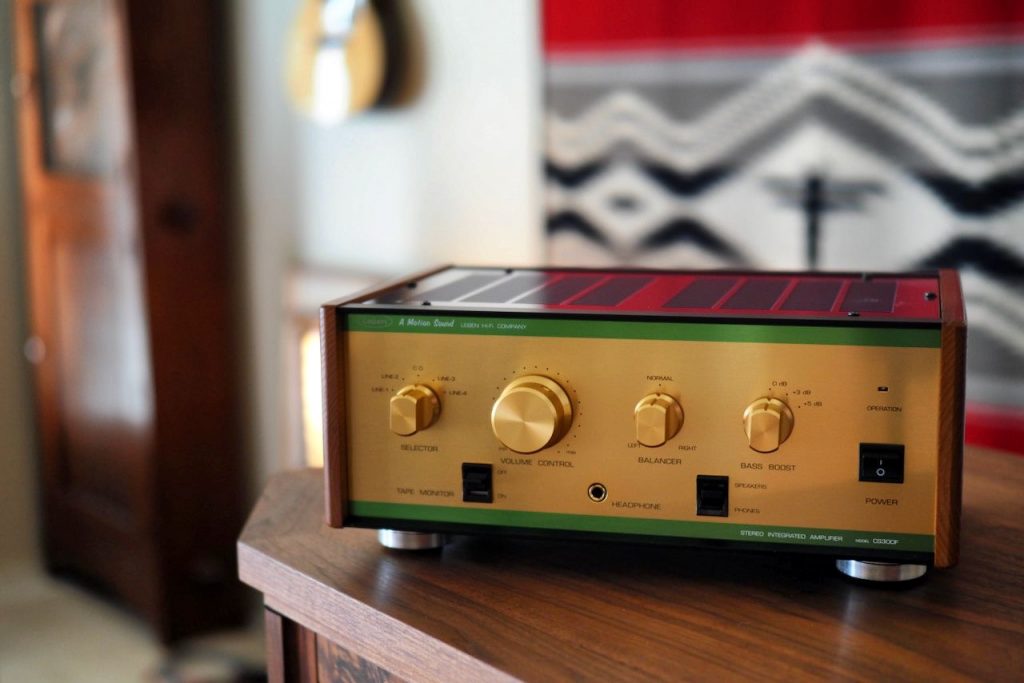
Over the years, I’ve either owned or written about most of the Leben HiFi Stereo Company’s products, including the CS-600 integrated amplifier, the CS-300X Limited Edition integrated amplifier, the RS-30EQ phono preamplifier, the CS-660P power amplifier, the RS-28CX preamplifier, the RS-100 & RS-100U line preamplifiers, and the new CS-600X integrated amplifier.
The Leben CS-300F was released in 2013, and somehow its debut escaped my notice. Like me, I’m thinking some of you may have missed the debut of the Leben CS-300F too, as the CS-300F remains one of the rarer Leben integrated amplifiers found in the listening rooms of Leben enthusiasts around the world.
I’ve always found the Leben components I’ve owned or reviewed to be of high quality, reliable, have low cost of upkeep, to represent good overall value for their level of performance, have an attractive appearance, have good sound quality and musicality, and just be a general joy to experience on a day-to-day basis.

In fact the integrated amplifier I’ve owned longer than any other is my Leben CS-600 integrated amplifier that was released in 2005, and which I bought after reviewing it in 2007, nearly 15 years ago now (photo above is the latest CS-600X version).
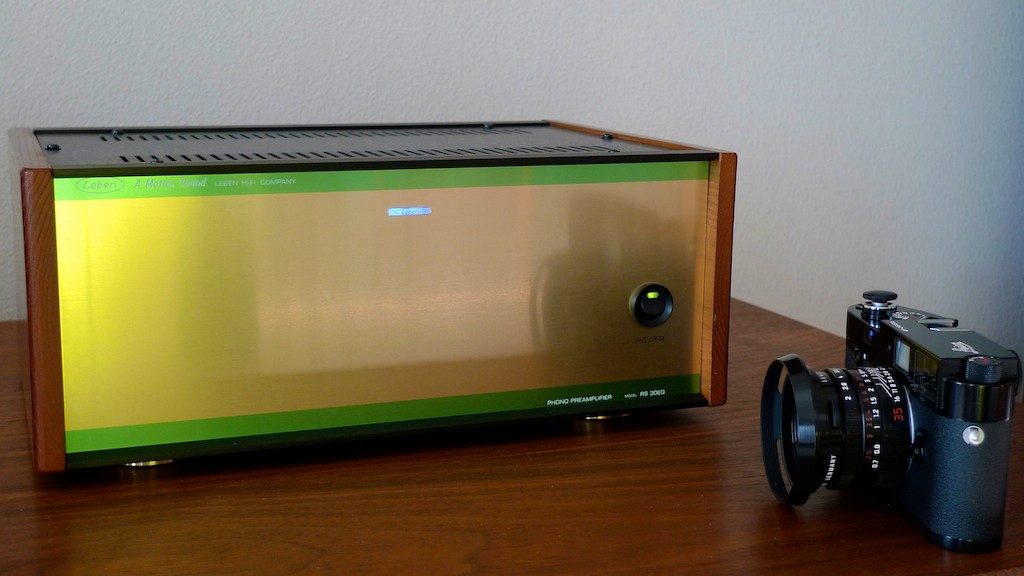
The Leben RS-30EQ phono preamplifier has been with me almost that long as well (photo above), and my plan is to keep both the CS-600 and RS-30EQ around forever. I just really enjoy them, and that’s typical of the sort of devotion Leben hifi products tend to inspire in their owners.
The Leben HiFi Stereo Company
Most of you reading this are familiar with the Leben HiFi Stereo Company in Japan, but for those who are late to the story, allow me give you a background refresher about the company that Mr. Taku Hyodo founded in 1992.
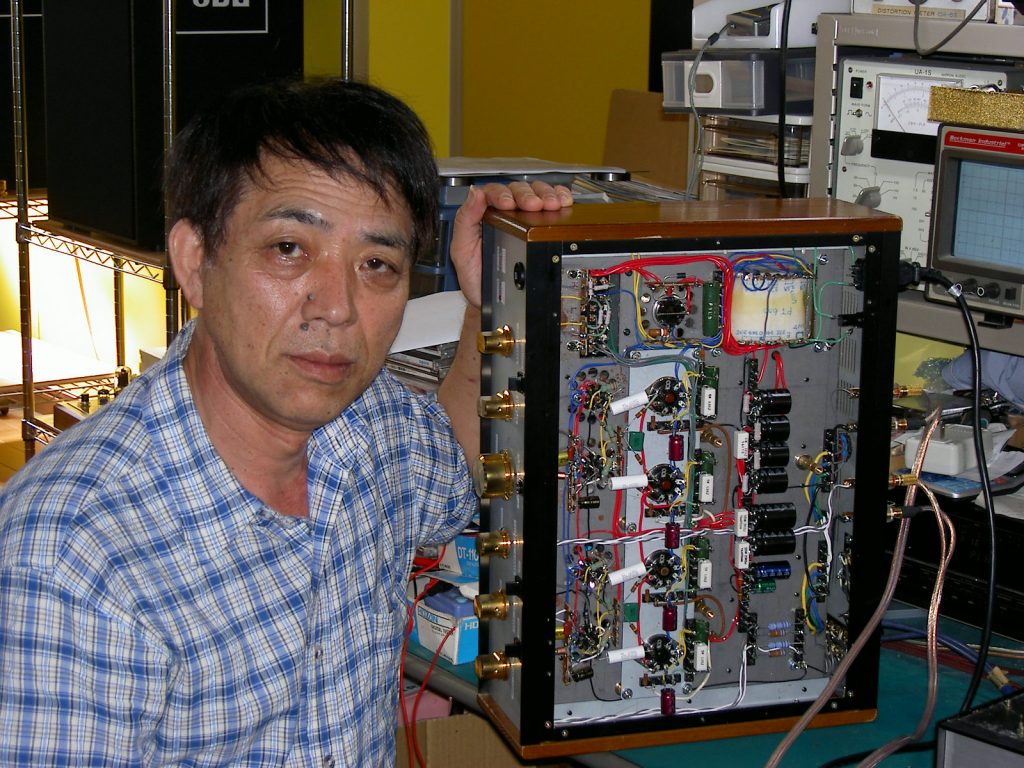
Prior to founding Leben, Hyodo-san designed electronics for the esteemed Luxman brand, whose roots go all the way back to 1925 when radio broadcasting was introduced in Japan.
During his Luxman years, Hyodo-san had made some amplifiers for himself and a few friends as fun projects. Hyodo-san's friends loved the sound of those amplifiers and encouraged him to use his obvious talents to start his own audio company.
Hyodo-san responded to his friends' encouragement by founding his own 'private label' audio electronics company in 1992 to reflect his philosophy that 'music is life.’
In keeping with his ‘music is life’ philosophy, Hyodo-san name his new company Leben, as "Leben" is a German word that literally means “life."
In the not so distant past, Leben products had been available exclusively in Japan, where they continue to enjoy a very enthusiastic following.
However, as interest in the exclusive Leben HiFi Company electronics boomed around the world, boutique audio exporter Yoshi Hontani (Muson Project) began to export Leben audio electronics in limited quantities for music enthusiasts in other countries so might enjoy their abundant charms.
As a result, Leben Hi-Fi Stereo Company products are now more readily available to enthusiasts around the world, although they are still rather exclusive audio electronics by any measure.
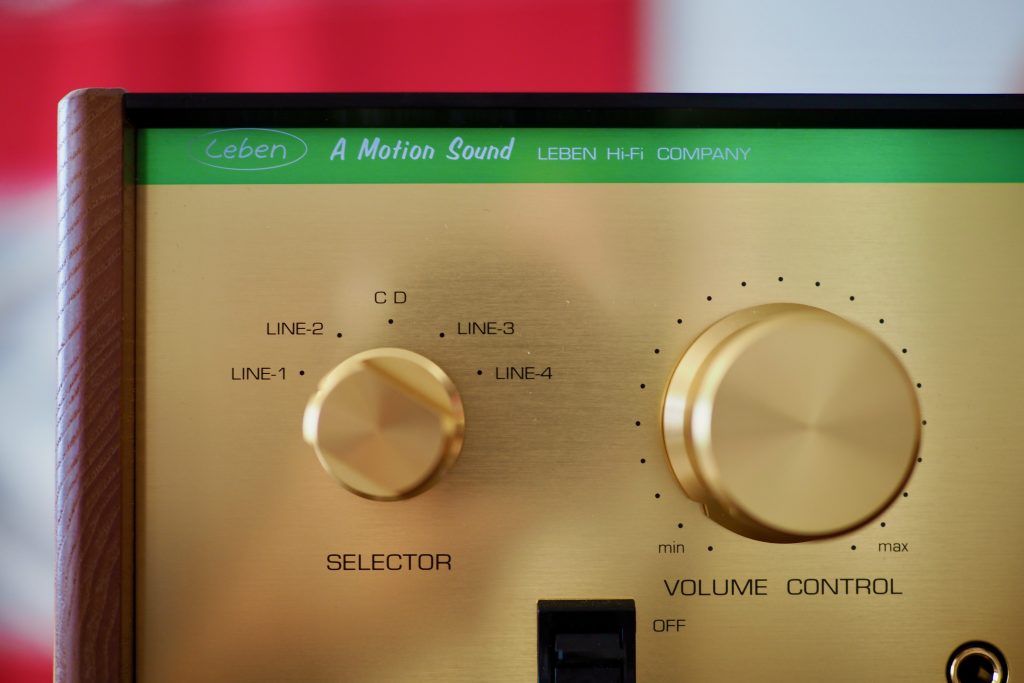
If you look closely at the front of the Leben CS-300F integrated amplifier's left top corner, you'll see that it says 'A Motion Sound' across the top (photo above).
I had asked Hyodo-San about the ‘A Motion Sound’ inscription, and he told me "When I was a youngster, my father worked as a movie projectionist and I went to see many movies with him. Paramount Pictures used to call a movie "A Motion Picture" and I adapted this phrase to Leben.”
The idea is that movies consist of many still shots of theatrical performances, that when played at speed on a film projector, brings the film to life-like motion for its viewers.
In the same way Hyodo-san’s "A Motion Sound" conveys the idea of when playing a recording of a musical performance, the recording of the musical performance attains ‘living e-motion’ through the Leben amplifier.
I asked Hyodo San what influences have shaped him as a designer:
"I have been listening to live music and playing musical instruments like the guitar, clarinet and drums since I was young. I was a professional acoustic guitarist for a few years in my twenties and now I continue to enjoy playing musical instruments as a hobby. My experiences performing and listening to live music helped me a lot in designing my amplifiers. Listening to live acoustic instruments guides my amplifier designs, as live music always helps people relax and enjoy the music.”
"For example, when designing an amplifier, audiophile grade components don't always bring better sound. If I were to make an amplifier with nothing but premium audiophile components, there is no guarantee that the amp will sound good. It is more important to select components by listening so that as a whole, the amplifier plays music better. The most important thing is to achieve a total musical balance.”
"I am aiming for a natural sound in my designs that allows the listener to relax and enjoy the music, so I always try to consult with as many ordinary listeners as possible, friends and family. I design my products for real people, the unspecified music lovers. I think Mike Eliot has it right (formerly an engineer with Mark Levinson, now Aria Audio) who said (paraphrased), "Don't rely on audiophile-grade parts to give you a musical sound. When you design a new amp, pick what you think are the most musical parts. Then consult with your wife or lover to see if they think it makes the music sound enjoyable as a reality check.”"
Leben amplification products are known for excelling at playing music in a natural and effortless way, being harmonically rich, tonally correct and very transparent, having a tight and tuneful bass response, and a very wide bandwidth.
The Leben CS-300F Integrated Amplifier
When you look at the Leben CS-300F integrated amplifier, one of the first things you’ll notice about it is that it has a purple top-plate instead of usual Leben CS-300X(S)’s titanium-grey painted top-plate.
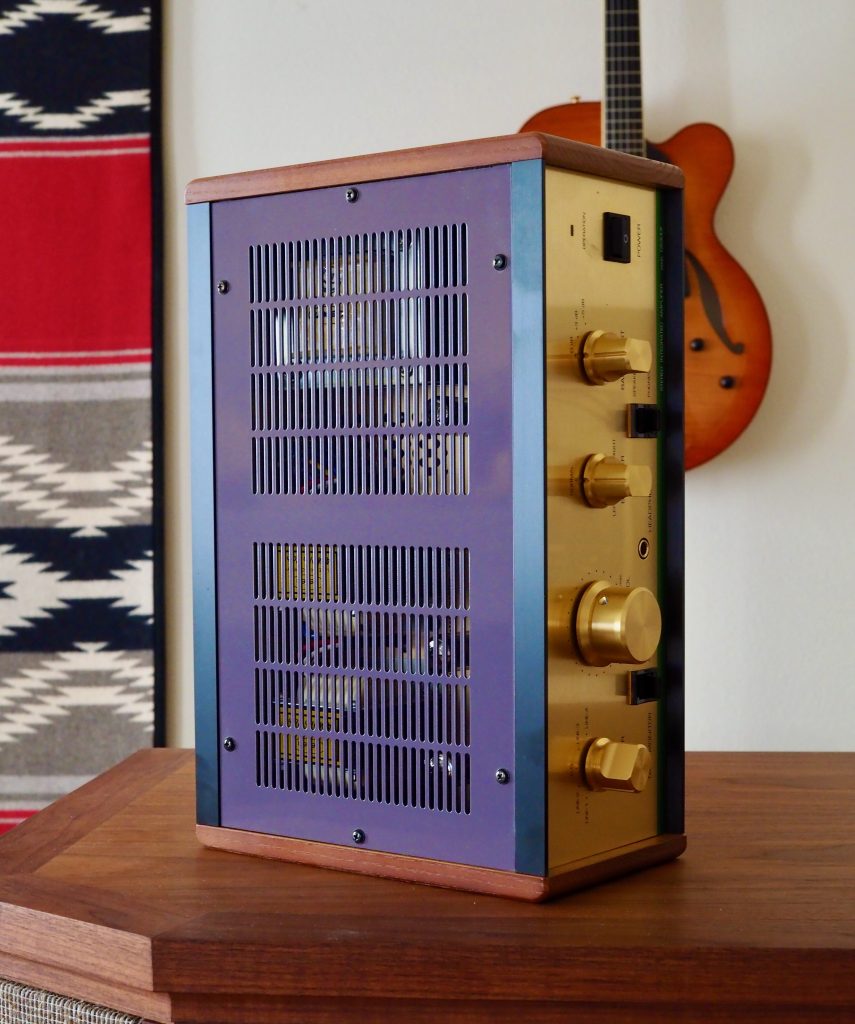
Leben enthusiasts were shocked when Hyodo-san selected a purple top-plate for the Leben CS-300F. I mean, who puts purple top-plates on hifi equipment, and why would Hyodo-san do that?
Purple clothing was worn in history by emperors, kings, and queens, as purple was considered the color of royalty, and was symbolic of ancient royalty's claims of being deities, descendants of deities, or spokespersons for deities.
So the purple top-cover signifies there is something special - something 'royal' - about the Leben CS-300F compared to the standard Leben CS-300X(S), which it shares a common chassis and basic circuit design with.
That something 'royal' is that the CS-300F utilizes NOS GE JAN 6197 pentode power tubes (photo left center) and 17EW8 drivers (photo right center) instead of the CS-300X(S)’s more typical EL84 pentode power tubes (photo left) and 12AX7A drivers (right).
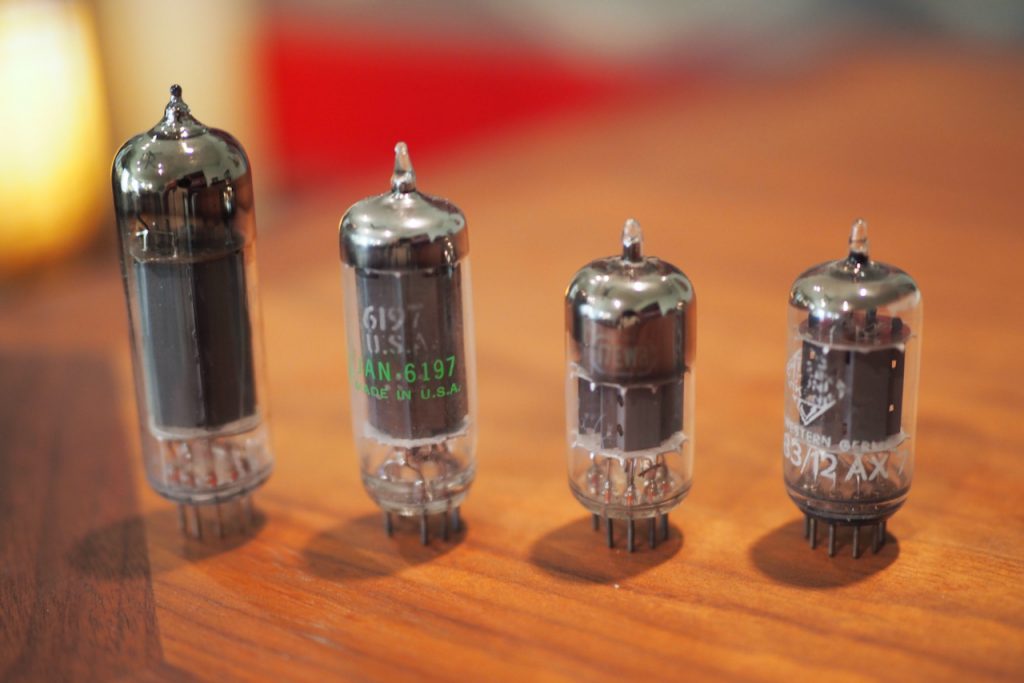
I suspect that the color purple was symbolic of Hyodo-san's high regard for the very transparent and clear sounding combination of the NOS GE JAN 6197 and 17EW8 vacuum tubes’ presentation, vacuum tubes with a sound quality that was ‘informed by the deities', so to speak - compared to the more typical EL84 and 12AX7A vacuum tubes found in the CS-300X(S).
As Yoshi-san related it to me, Hyodo-san wanted to do something new design-wise, as he was impressed with the performance of the NOS GE JAN 6197 power tubes and 17EW8 drivers. Hyodo-san wanted to showcase these remarkable vintage vacuum tubes performance in a new integrated amplifier model, so he bought up a large stock of NOS GE JAN 6197 & 17EW8 vacuum tubes for use in what would eventually become known as the Leben CS-300F.
The NOS GE JAN 6197 power tubes and 17EW8 drivers - as far as I can determine - have never been used in a hifi amplifier before Hyodo-san’s design of the Leben CS-300F.
Size-wise the 6197 is a diminutive vacuum tube even in comparison to the already svelte EL84. The 6197 looks like like a slightly taller driver tube rather than a power tube.
According to The National Valve Museum "The 6197 is a special quality power pentode that was designed for operation for long periods either full on or at cut-off. The applications were within digital computers of the 1950s. Also on the data-sheet is a specification for operation as a Class A amplifier."
The RCA Receiving Tube Manual says the 17EW8 is high-mu twin triode for use in "... rf-amplifier and oscillator-mixing circuits in FM and AM radio receivers."
While the 6197 power tubes and 17EW8 drivers are not current production vacuum tubes, they do appear to be relatively abundant in my brief survey of websites selling vacuum tubes.
Prices of 6197 tubes are very reasonable at the time I checked, being about $3 USD to $7 USD per tube depending on the seller. The 17EW8 driver tubes sell for between $5 USD and $10 USD depending on the seller.
That's a tremendously good value for high-quality NOS vacuum tubes, and if you are contemplating being a Leben CS-300F owner I suggest that it would be wise to purchase a number of sets of tubes with the future in mind, given there are no current production versions of these vacuum tubes.
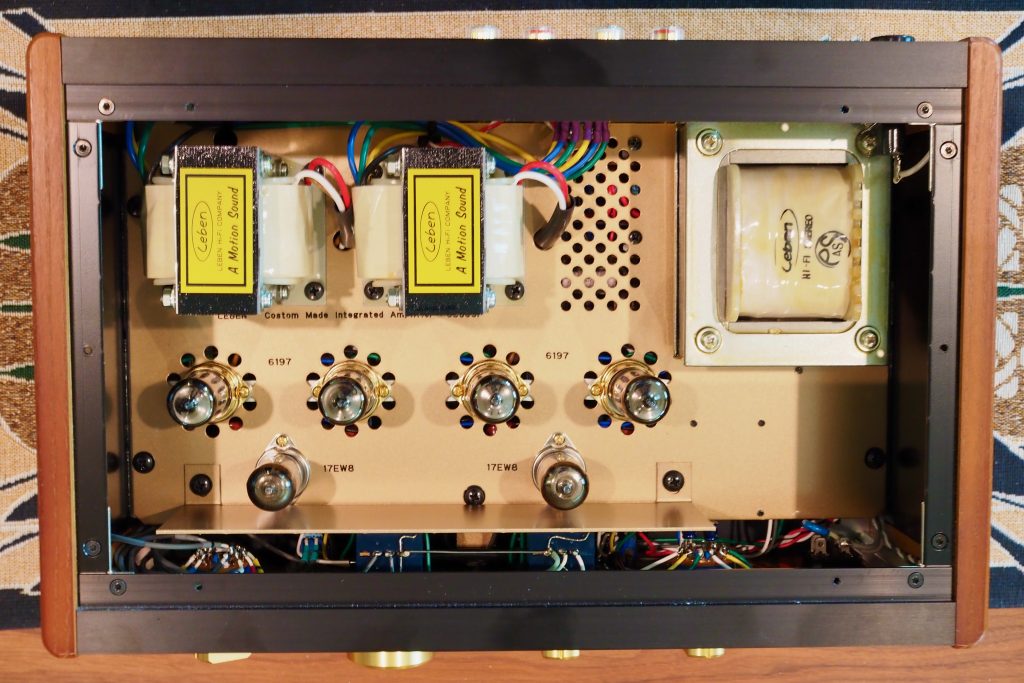
Hyodo-san based the circuit of the CS-300F on the same Class A-B push-pull circuit that has been so successful in the various versions of Leben CS-300, but optimized the component choices and their values to bring out Hyodo-san’s desired voicing from the NOS GE JAN 6197 power tubes and 17EW8 drivers in his new CS-300F.
Please note, that even though the circuits are similar between the CS-300F and the CS-300X(S), due to the differences in component values needed for the NOS GE JAN 6197 power tubes and 17EW8 drivers you cannot substitute EL84 and 12AX7A vacuum tubes for them, or vice-versa, and by doing so you could potentially damage the vacuum tubes and the amplifiers. You’ve been warned.
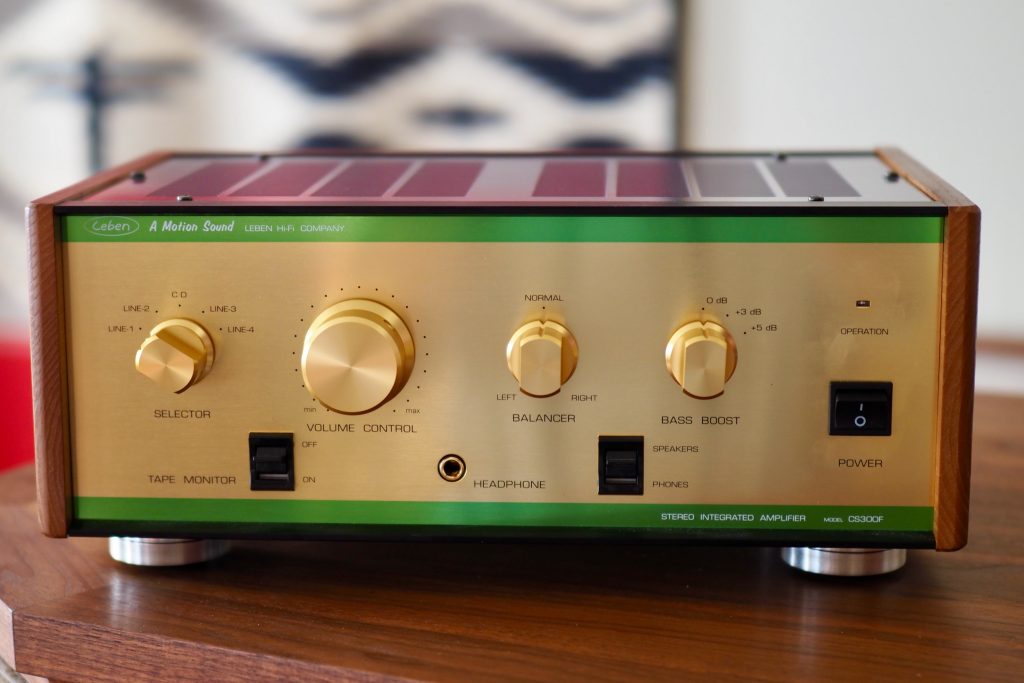
Let’s do a ‘walk-around’ of the Leben CS-300F’s features. On the front you see, from left to right, the source selector, the tape monitor switch, the volume control, the headphone jack, a balance control, a switch to select either loudspeakers or headphones for listening, a bass boost selector that allows the addition of +3 dB or +5 dB of boost, and power switch, and an indicator light that illuminates when the CS-300F is powered up.
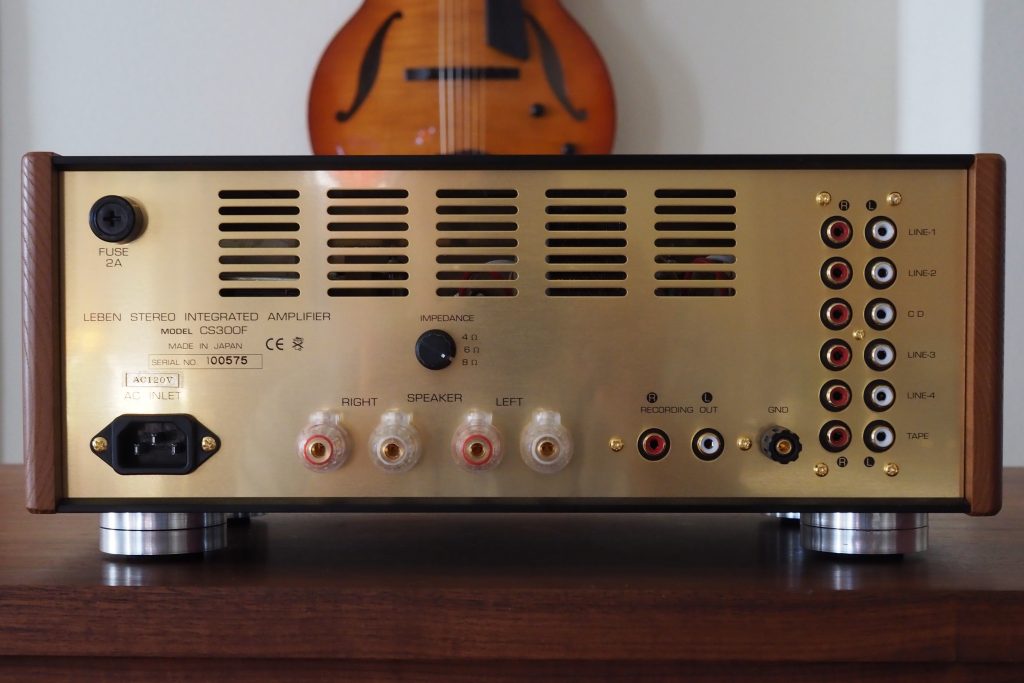
On the back of the CS-300F’s chassis, from left to right, are the fuse holder, the AC inlet, the loudspeaker binding posts, an impedance selector with settings for 4 Ohm, 6 Ohm, and 8 Ohm loudspeakers. Next are a pair of recording out female RCAs, a ground connection point, and six pairs of female RCA inputs, four for line level sources, one dedicated CD input, and a dedicated tape input.

On top is the aforementioned ventilated purple top cover.
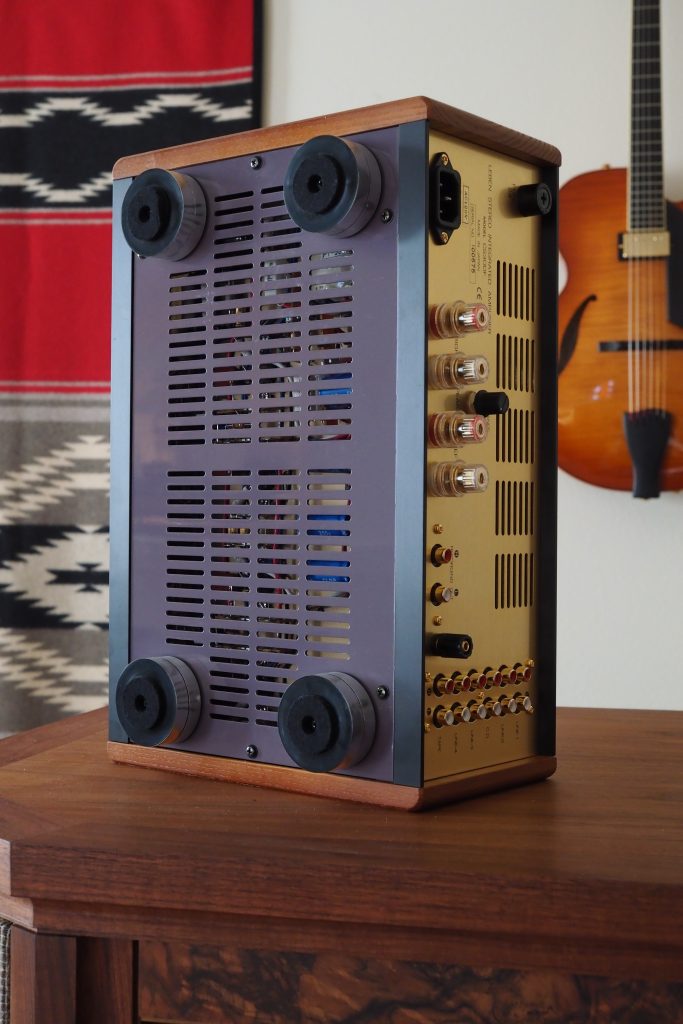
On the bottom of the chassis is another ventilated purple bottom plate that is the twin of the purple top cover - gasp! (It looks less purple in this photo because of the different lighting. It's still purple.)
Also on the bottom are four nice looking equipment footers, each fitted with a felt pad to keep your furniture from getting scratched up.
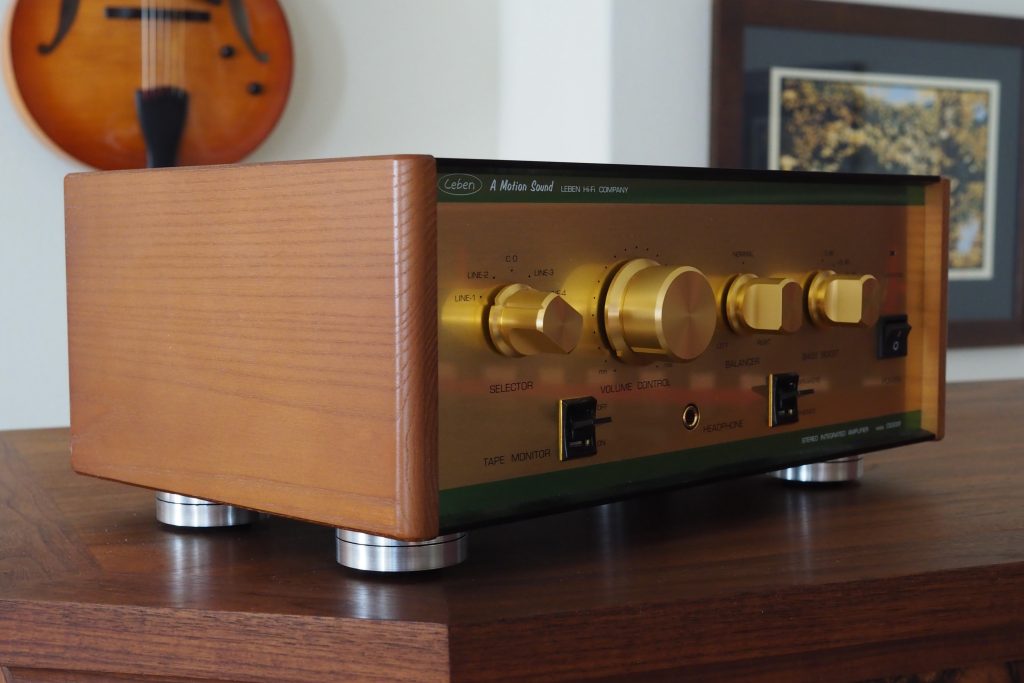
There are attractive white ash side cheeks on the CS-300F, which I think are a classy touch.
Review System
Let’s go back to the Leben ‘genesis’ story for a moment. As I mentioned earlier, if you look closely at the front of the Leben CS-300F integrated amplifier, you'll see that it says 'A Motion Sound' across the top.

When I had asked Hyodo-San about the ‘A Motion Sound’ inscription, and he had told me, "When I was a youngster, my father worked as a movie projectionist and I went to see many movies with him. Paramount Pictures used to call a movie "A Motion Picture" and I adapted this phrase to Leben.”
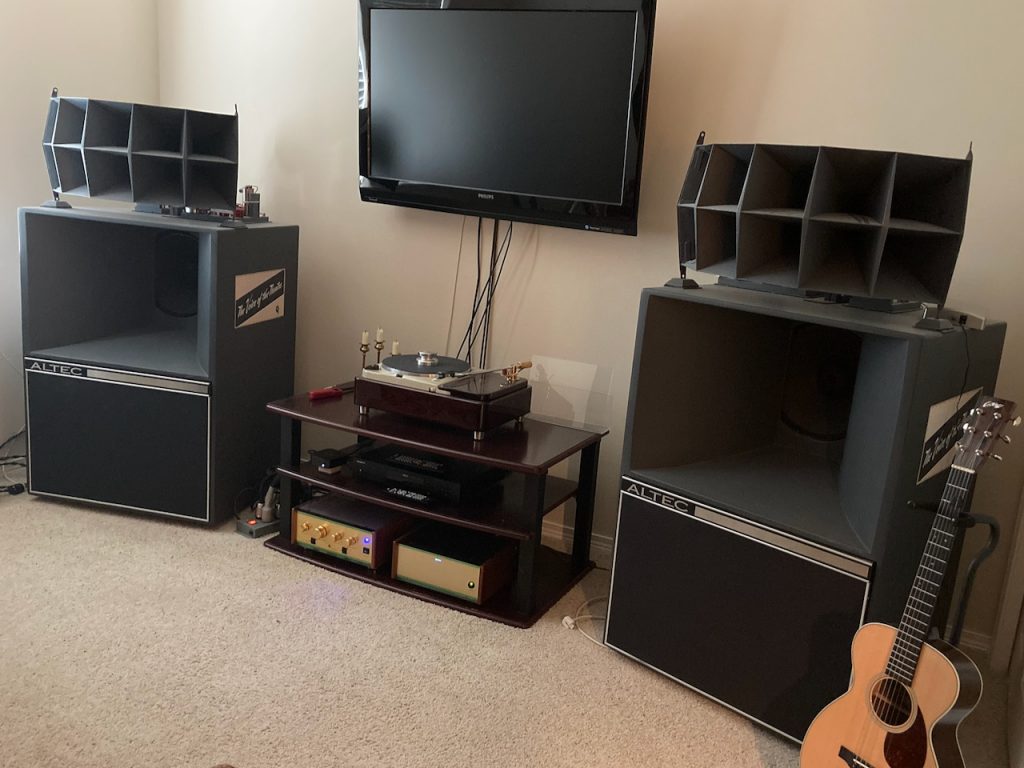
I thought it would be appropriate to honor Hyodo-san and his father’s movie projectionist roots in this article by using actual movie theater loudspeakers from the past, my restored vintage Altec A5 Voice of the Theatre loudspeakers (photo above).
My Altec A5 Voice of the Theatre loudspeakers have served as a fun, nostalgic, and great sounding foundation for my audio-visual system for quite a few years now, and Altec A5 loudspeakers like mine were used behind the screens of many of the smaller and mid-sized movie theaters in North America, and elsewhere, for sound reenforcement after their introduction in 1945.
I built custom adjustable crossovers for my vintage Altec A5 loudspeakers based upon the Altec A5 crossover circuit design by Jean Hiraga. I also incorporated a few design changes into the crossover circuit suggested by friend Yazaki-san, which allows me to fine-tune the balance of the high-frequencies to the low-frequencies to match what is needed for the size of the room that my Altec A5s are in (an almost near-field listening arrangement).
My audiovisual system has an aging Philips television hung up on the wall so I can watch movies or TV shows, kept company by an OPPO UDP-203 Blu-ray player for spinning DVD or Blu-Ray movies, or an occasional CD.
I use an Apple TV for streaming Amazon Prime, Netflix, YouTube, Peacock TV, Kanopy, and the like.
I’ve found that interconnect cables with silver or silver hybrid conductors sounded too forward and bright with the Leben CS-300F for my tastes, and that my old recording studio favorites, the Belden 8402 tinned-copper microphone cable interconnects, provided a more natural tonal balance with the CS-300F in my AV system.
The speaker cables used for this article were the Duelund DCA16GA tinned-copper speaker cables, which are my go-to cables for my various vintage Altec loudspeakers.
For power cables I used a mix of an Acoustic Revive ‘Absolute’, Acoustic Revive ‘Power Reference TripleC NCF’, and Sablon Audio ‘Petit Corona’, all of which are excellent cables.
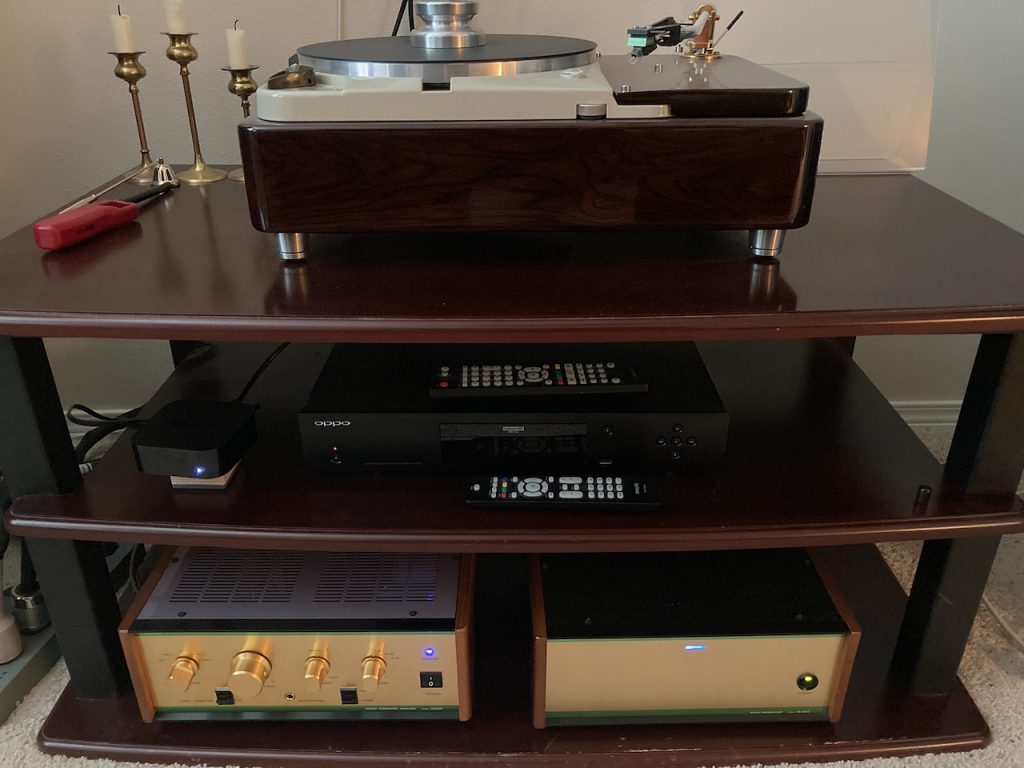
My restored Thorens TD 124 turntable was my analog source for music listening (Artisan Fidelity plinth, Schick tonearm, Soundsmith Carmen Mk II phono cartridge).
Listening Impressions

Ok, that's all for now. As soon as the full article is published at Positive Feedback I'll update this to let you know.
As always, thanks for stopping by, and may the tone be with you!





























